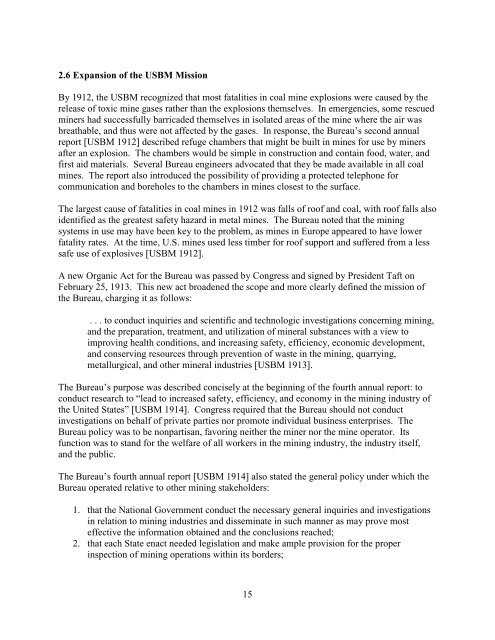One Hundred Years of Federal Mining Safety and Health Research
One Hundred Years of Federal Mining Safety and Health Research
One Hundred Years of Federal Mining Safety and Health Research
- No tags were found...
Create successful ePaper yourself
Turn your PDF publications into a flip-book with our unique Google optimized e-Paper software.
2.6 Expansion <strong>of</strong> the USBM Mission<br />
By 1912, the USBM recognized that most fatalities in coal mine explosions were caused by the<br />
release <strong>of</strong> toxic mine gases rather than the explosions themselves. In emergencies, some rescued<br />
miners had successfully barricaded themselves in isolated areas <strong>of</strong> the mine where the air was<br />
breathable, <strong>and</strong> thus were not affected by the gases. In response, the Bureau’s second annual<br />
report [USBM 1912] described refuge chambers that might be built in mines for use by miners<br />
after an explosion. The chambers would be simple in construction <strong>and</strong> contain food, water, <strong>and</strong><br />
first aid materials. Several Bureau engineers advocated that they be made available in all coal<br />
mines. The report also introduced the possibility <strong>of</strong> providing a protected telephone for<br />
communication <strong>and</strong> boreholes to the chambers in mines closest to the surface.<br />
The largest cause <strong>of</strong> fatalities in coal mines in 1912 was falls <strong>of</strong> ro<strong>of</strong> <strong>and</strong> coal, with ro<strong>of</strong> falls also<br />
identified as the greatest safety hazard in metal mines. The Bureau noted that the mining<br />
systems in use may have been key to the problem, as mines in Europe appeared to have lower<br />
fatality rates. At the time, U.S. mines used less timber for ro<strong>of</strong> support <strong>and</strong> suffered from a less<br />
safe use <strong>of</strong> explosives [USBM 1912].<br />
A new Organic Act for the Bureau was passed by Congress <strong>and</strong> signed by President Taft on<br />
February 25, 1913. This new act broadened the scope <strong>and</strong> more clearly defined the mission <strong>of</strong><br />
the Bureau, charging it as follows:<br />
. . . to conduct inquiries <strong>and</strong> scientific <strong>and</strong> technologic investigations concerning mining,<br />
<strong>and</strong> the preparation, treatment, <strong>and</strong> utilization <strong>of</strong> mineral substances with a view to<br />
improving health conditions, <strong>and</strong> increasing safety, efficiency, economic development,<br />
<strong>and</strong> conserving resources through prevention <strong>of</strong> waste in the mining, quarrying,<br />
metallurgical, <strong>and</strong> other mineral industries [USBM 1913].<br />
The Bureau’s purpose was described concisely at the beginning <strong>of</strong> the fourth annual report: to<br />
conduct research to “lead to increased safety, efficiency, <strong>and</strong> economy in the mining industry <strong>of</strong><br />
the United States” [USBM 1914]. Congress required that the Bureau should not conduct<br />
investigations on behalf <strong>of</strong> private parties nor promote individual business enterprises. The<br />
Bureau policy was to be nonpartisan, favoring neither the miner nor the mine operator. Its<br />
function was to st<strong>and</strong> for the welfare <strong>of</strong> all workers in the mining industry, the industry itself,<br />
<strong>and</strong> the public.<br />
The Bureau’s fourth annual report [USBM 1914] also stated the general policy under which the<br />
Bureau operated relative to other mining stakeholders:<br />
1. that the National Government conduct the necessary general inquiries <strong>and</strong> investigations<br />
in relation to mining industries <strong>and</strong> disseminate in such manner as may prove most<br />
effective the information obtained <strong>and</strong> the conclusions reached;<br />
2. that each State enact needed legislation <strong>and</strong> make ample provision for the proper<br />
inspection <strong>of</strong> mining operations within its borders;<br />
15
















